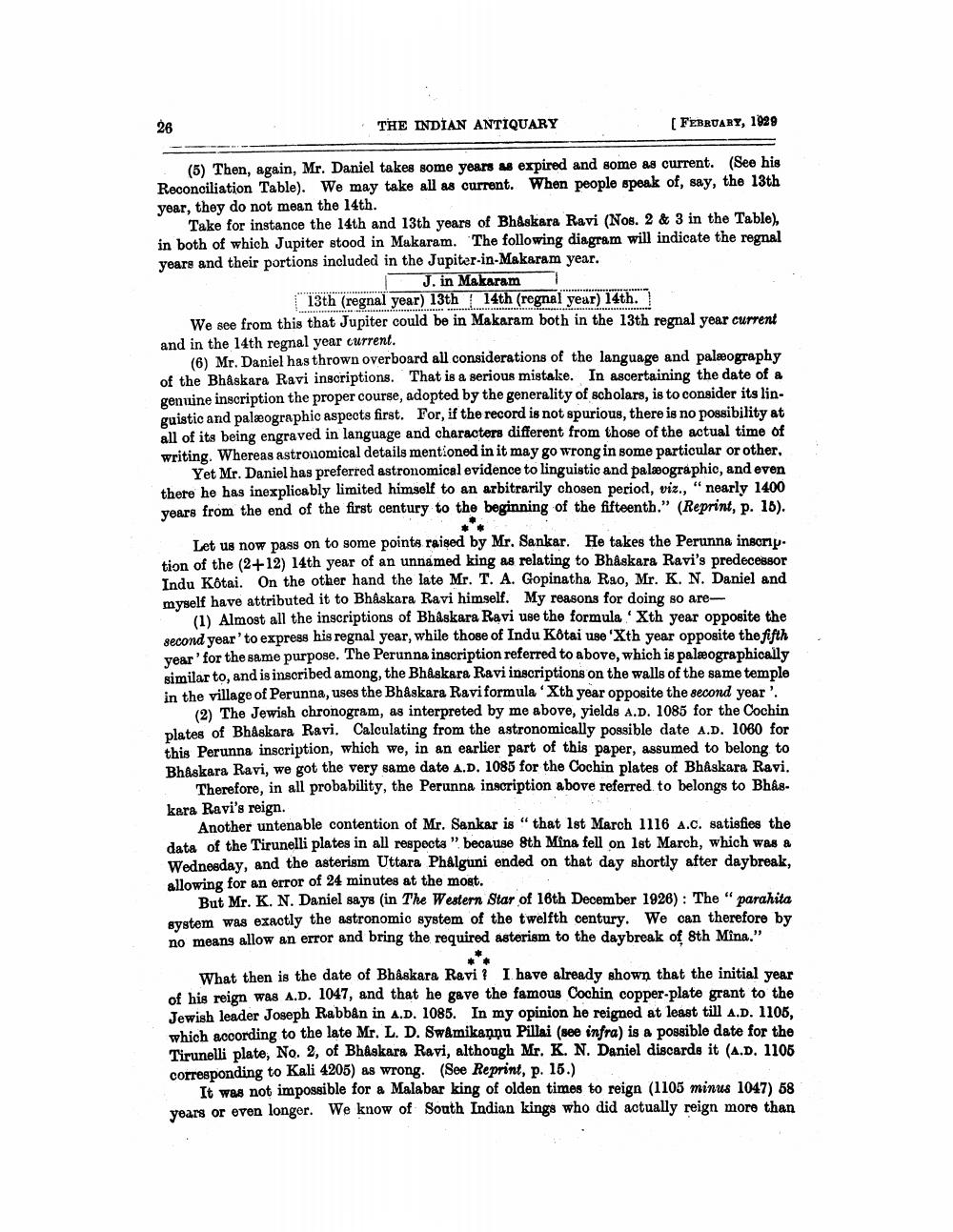________________
THE INDIAN ANTIQUARY
[ FEBRUARY, 1929
(5) Then, again, Mr. Daniel takes some years as expired and some as current. (See his Reconciliation Table). We may take all as current. When people speak of, say, the 13th year, they do not mean the 14th.
Take for instance the 14th and 13th years of Bhaskara Ravi (Nos. 2 & 3 in the Table), in both of which Jupiter stood in Makaram. The following diagram will indicate the regnal years and their portions included in the Jupiter-in-Makaram year.
J. in Makaram 113th (regnal year) 13th 14th (regnal year) 14th. We see from this that Jupiter could be in Makaram both in the 13th regnal year current and in the 14th regnal year current.
(6) Mr. Daniel has thrown overboard all considerations of the language and palæography of the Bhaskara Ravi inscriptions. That is a serious mistake. In ascertaining the date of a genuine inscription the proper course, adopted by the generality of scholars, is to consider its linguistic and palæographic aspects first. For, if the record is not spurious, there is no possibility at all of its being engraved in language and characters different from those of the actual time of writing. Whereas astronomical details mentioned in it may go wrong in some particular or other,
Yet Mr. Daniel has preferred astronomical evidence to linguistic and palmographic, and even there he has inexplicably limited himself to an arbitrarily chosen period, viz., "nearly 1400 years from the end of the first century to the beginning of the fifteenth." (Reprint, p. 15).
Let us now pass on to some points raised by Mr. Sankar. He takes the Perunna inscrip tion of the (2+12) 14th year of an unnamed king as relating to Bhaskara Ravi's predecessor Indu Kotai. On the other hand the late Mr. T. A. Gopinatha Rao, Mr. K. N. Daniel and myself have attributed it to Bhaskara Ravi himself. My reasons for doing so are
(1) Almost all the inscriptions of Bhaskara Ravi use the formula Xth year opposite the second year'to express his regnal year, while those of Indu Kotai use 'Xth year opposite the fifth year for the same purpose. The Perunna inscription referred to above, which is palæographically similar to, and is inscribed among the Bhaskara Ravi inscriptions on the walls of the same temple in the village of Perunna, uses the Bhaskara Ravi formula 'Xth year opposite the second year'.
(2) The Jewish chronogram, as interpreted by me above, yields A.D. 1085 for the Cochin plates of Bhaskara Ravi. Calculating from the astronomically possible date A.D. 1060 for this Perunna inscription, which we, in an earlier part of this paper, assumed to belong to Bhaskara Ravi, we got the very same date A.D. 1085 for the Cochin plates of Bhaskara Ravi.
Therefore, in all probability, the Perunna inscription above referred to belongs to Bhas. kera Ravi's reign.
Another untenable contention of Mr. Sankar is "that 1st March 1116 A.C. satisfies the data of the Tirunelli plates in all respecta " because 8th Mina fell on 1st March, which was a Wednesday, and the asterism Uttara Phálguni ended on that day shortly after daybreak, allowing for an error of 24 minutes at the most. .
But Mr. K. N. Daniel says (in The Western Star of 16th December 1926): The "parahita system was exactly the astronomic system of the twelfth century. We can therefore by no means allow an error and bring the required asterism to the daybreak of 8th Mina."
What then is the date of Bhaskara Ravi! I have already shown that the initial year of his reign was A.D. 1047, and that he gave the famous Cochin copper-plate grant to the Jewish leader Joseph Rabbân in A.D. 1085. In my opinion he reigned at least till A.D. 1105, which according to the late Mr. L. D. Swamikannu Pillai (see infra) is a possible date for the Tirunelli plate, No. 2, of Bhaskara Ravi, although Mr. K. N. Daniel discards it (A.D. 1105 corresponding to Kali 4205) as wrong. (See Reprint, p. 15.)
It was not impossible for a Malabar king of olden times to reign (1105 minus 1047) 58 years or even longer. We know of South Indian kings who did actually reign more than




